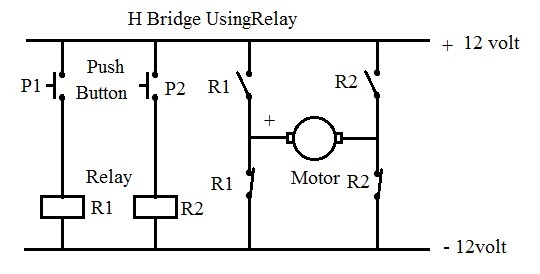hevans1944
Hop - AC8NS
That wasn't what I was thinking. I was thinking more along the lines of the picture below with the DPDT switch replaced with a DPDT relay (a relay with two Form-C contacts):You refer to an h-bridge, do you?

But your link to the H-bridge arrangement works well with two Form-C relays, and it doesn't require another relay to turn the motor on and off:

I think I like the H-bridge arrangement better, but a DPDT (two Form-C contacts) relay for direction control, along with a second relay (SPST or DPDT) to switch power on and off to the motor, allows for independent direction and motor on/off control, and is the way I have always implemented DC motor controls. I think the H-Bridge version is better because (1) the motor is de-energized if neither relay is actuated; (2) the motor runs in the appropriate direction when either relay is actuated; and (3) the motor windings are shorted and the motor does not run if either both relays are actuated simultaneously or both relays are de-actuated simultaneously. Therefore Relay 1 could be labeled FORWARD and Relay 2 could be labeled REVERSE.
More importantly for @Goldhelmeth's project, the H-bridge circuit only uses two of the four SPDT relays on his Bluetooth remote-controlled relay board. That leaves one relay available for controlling a fan and another relay to turn on a hot-plate to heat water for a French-press coffee maker... the finest way to make a cup of coffee IMHO. All this might be a moot point since the 4-channel Bluetooth module has now been replaced with a 16-channel module controlled by a Raspberry Pi microcontroller or minicomputer or whatever you want to call it. That's a pretty big step up for someone who yesterday didn't know diddly about electronics or electrical circuits!
